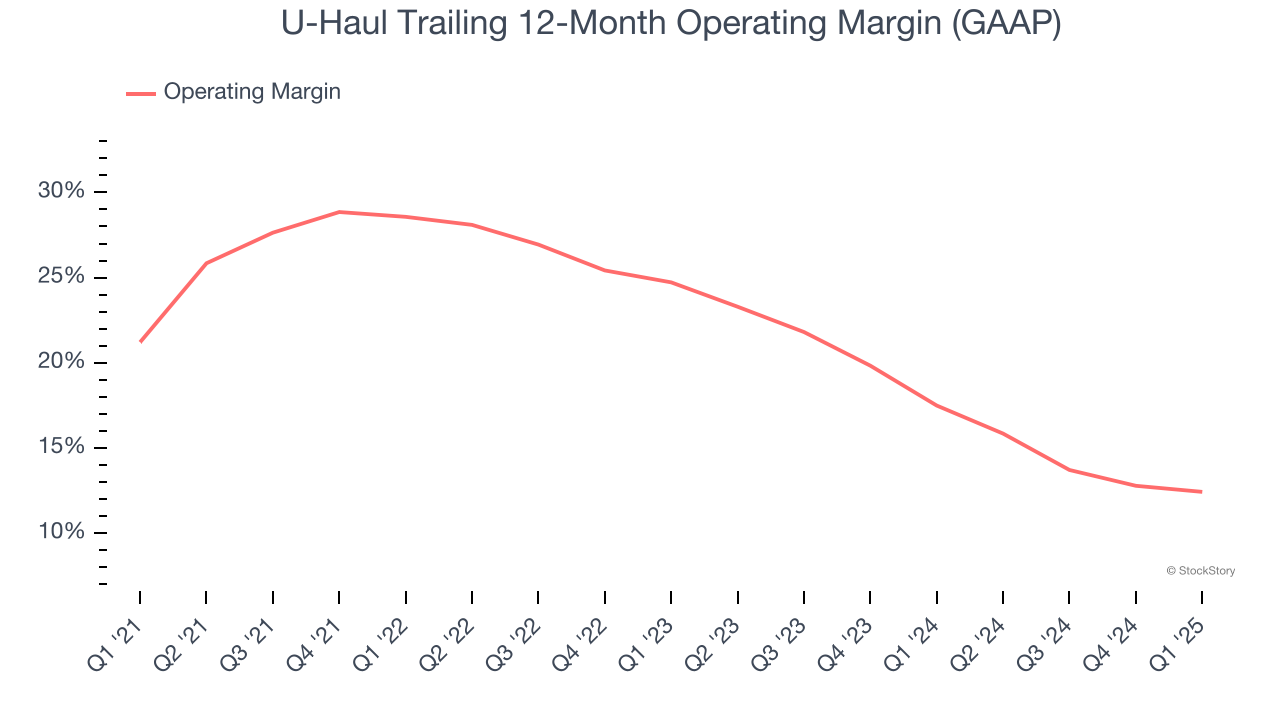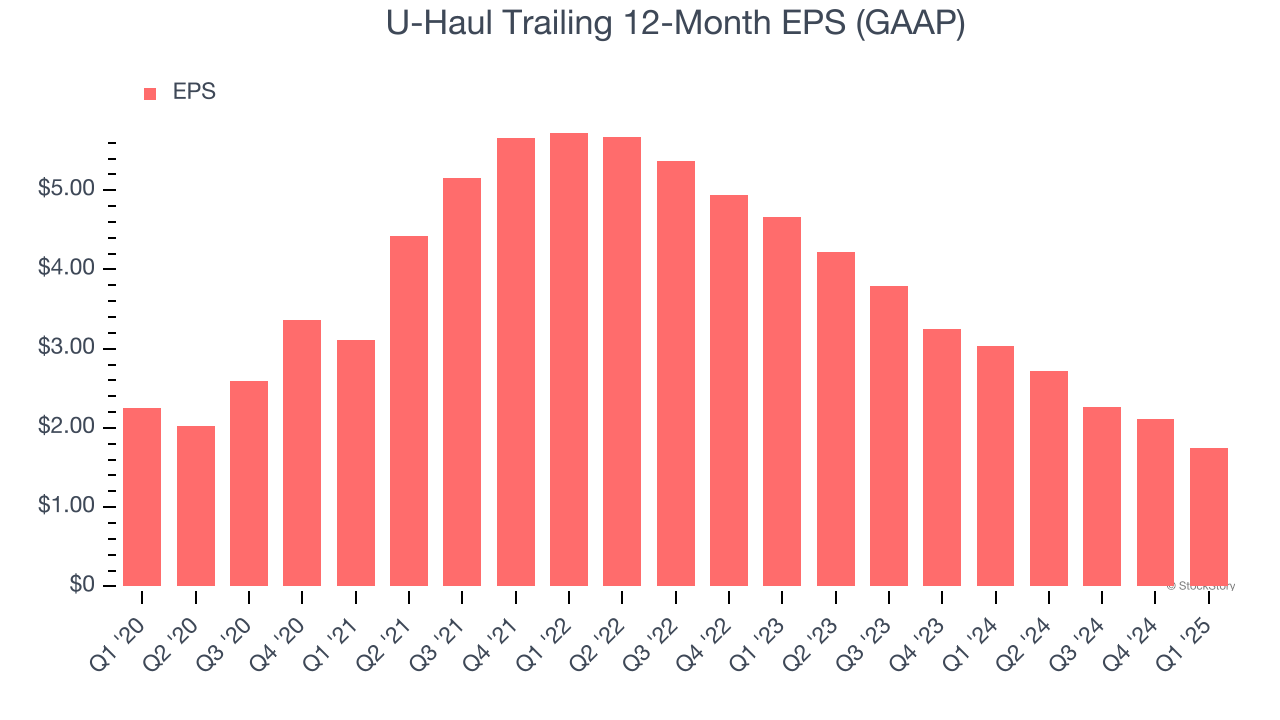
Moving and storage solutions provider U-Haul (NYSE: UHAL) beat Wall Street’s revenue expectations in Q1 CY2025, with sales up 12.5% year on year to $1.23 billion. Its GAAP loss of $0.41 per share was significantly below analysts’ consensus estimates.
Is now the time to buy U-Haul? Find out by accessing our full research report, it’s free.
U-Haul (UHAL) Q1 CY2025 Highlights:
- Revenue: $1.23 billion vs analyst estimates of $1.16 billion (12.5% year-on-year growth, 6.7% beat)
- EPS (GAAP): -$0.41 vs analyst estimates of -$0.17 (significant miss)
- Operating Margin: -3.5%, in line with the same quarter last year
- Market Capitalization: $10.96 billion
“We are seeing the high prices we paid for fleet replacements over the last thirty months impact the income statement. Reduced gains on the sale of rental equipment and increased fleet depreciation expense decreased earnings by nearly $260 million for the year compared to fiscal 2024. We have increased depreciation further to recognize this expense in the current period,” stated Joe Shoen, chairman of U-Haul Holding Company.
Company Overview
Founded by a husband and wife duo, U-Haul (NYSE: UHAL) is a provider of rental trucks and storage facilities.
Sales Growth
Examining a company’s long-term performance can provide clues about its quality. Any business can put up a good quarter or two, but many enduring ones grow for years. Over the last five years, U-Haul grew its sales at a decent 7.9% compounded annual growth rate. Its growth was slightly above the average industrials company and shows its offerings resonate with customers.

We at StockStory place the most emphasis on long-term growth, but within industrials, a half-decade historical view may miss cycles, industry trends, or a company capitalizing on catalysts such as a new contract win or a successful product line. U-Haul’s recent performance shows its demand has slowed as its revenue was flat over the last two years. We also note many other Ground Transportation businesses have faced declining sales because of cyclical headwinds. While U-Haul’s growth wasn’t the best, it did do better than its peers. 
This quarter, U-Haul reported year-on-year revenue growth of 12.5%, and its $1.23 billion of revenue exceeded Wall Street’s estimates by 6.7%.
We also like to judge companies based on their projected revenue growth, but not enough Wall Street analysts cover the company for it to have reliable consensus estimates.
Unless you’ve been living under a rock, it should be obvious by now that generative AI is going to have a huge impact on how large corporations do business. While Nvidia and AMD are trading close to all-time highs, we prefer a lesser-known (but still profitable) stock benefiting from the rise of AI. Click here to access our free report one of our favorites growth stories.
Operating Margin
U-Haul has been a well-oiled machine over the last five years. It demonstrated elite profitability for an industrials business, boasting an average operating margin of 20.9%. This result isn’t too surprising as its gross margin gives it a favorable starting point.
Looking at the trend in its profitability, U-Haul’s operating margin decreased by 8.8 percentage points over the last five years. This raises questions about the company’s expense base because its revenue growth should have given it leverage on its fixed costs, resulting in better economies of scale and profitability.

In Q1, U-Haul generated an operating profit margin of negative 3.5%, in line with the same quarter last year. This indicates the company’s cost structure has recently been stable.
Earnings Per Share
Revenue trends explain a company’s historical growth, but the long-term change in earnings per share (EPS) points to the profitability of that growth – for example, a company could inflate its sales through excessive spending on advertising and promotions.
Sadly for U-Haul, its EPS declined by 4.9% annually over the last five years while its revenue grew by 7.9%. This tells us the company became less profitable on a per-share basis as it expanded due to non-fundamental factors such as interest expenses and taxes.

We can take a deeper look into U-Haul’s earnings to better understand the drivers of its performance. As we mentioned earlier, U-Haul’s operating margin was flat this quarter but declined by 8.8 percentage points over the last five years. This was the most relevant factor (aside from the revenue impact) behind its lower earnings; taxes and interest expenses can also affect EPS but don’t tell us as much about a company’s fundamentals.
Like with revenue, we analyze EPS over a more recent period because it can provide insight into an emerging theme or development for the business.
For U-Haul, its two-year annual EPS declines of 38.7% show it’s continued to underperform. These results were bad no matter how you slice the data.
In Q1, U-Haul reported EPS at negative $0.41, down from negative $0.05 in the same quarter last year. This print missed analysts’ estimates. Over the next 12 months, Wall Street expects U-Haul’s full-year EPS of $1.75 to grow 101%.
Key Takeaways from U-Haul’s Q1 Results
We were impressed by how significantly U-Haul blew past analysts’ revenue expectations this quarter. On the other hand, its EPS missed. Overall, this was a weaker quarter. The stock remained flat at $62.25 immediately after reporting.
Should you buy the stock or not? We think that the latest quarter is only one piece of the longer-term business quality puzzle. Quality, when combined with valuation, can help determine if the stock is a buy. We cover that in our actionable full research report which you can read here, it’s free.






